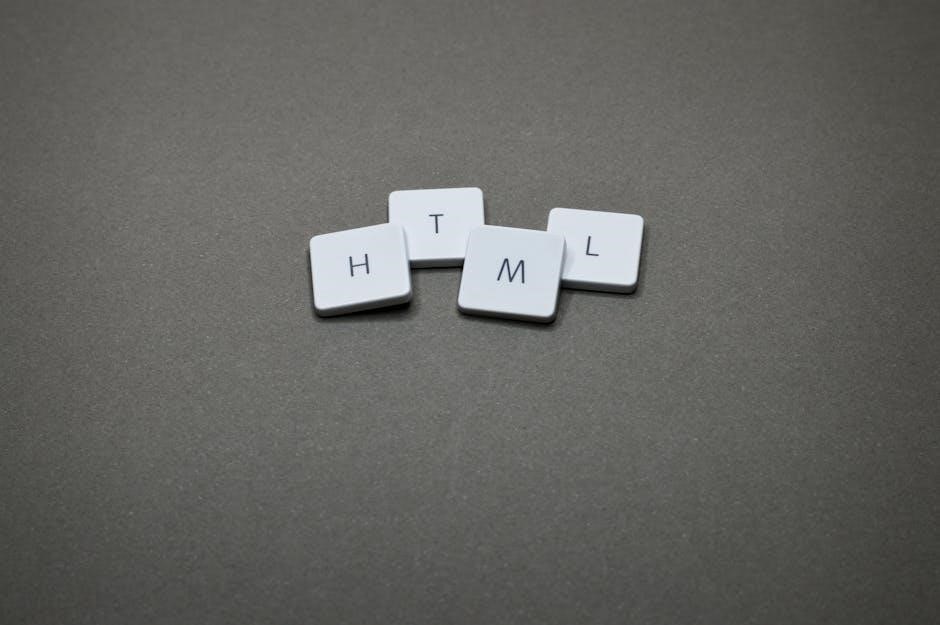Hydraulic symbols are graphical representations used to design and troubleshoot hydraulic systems. They standardize communication, ensuring clarity in representing components like pumps, valves, and cylinders. ISO 1219-1:2012 provides the framework for these symbols, enabling universal understanding. Resources like PDF documents and eBooks offer detailed explanations, aiding engineers in circuit design and system maintenance.
1.1 Overview of Hydraulic Symbols
Hydraulic symbols are standardized graphical representations used to depict components and systems in hydraulic circuits. They simplify the design, analysis, and troubleshooting of fluid power systems. These symbols, defined by ISO 1219-1:2012, cover basic components like pumps, motors, and valves, as well as complex systems. They provide a universal language for engineers, ensuring clarity and consistency. Symbols are categorized into basic and composite types, with detailed descriptions available in resources like PDF guides and educational materials, aiding in accurate circuit diagram creation and interpretation.
1.2 Importance of Standardization in Hydraulic Symbols
Standardization in hydraulic symbols ensures universal understanding and consistency across industries. Compliance with ISO 1219-1:2012 guarantees that symbols are recognized globally, reducing errors and enhancing collaboration. Without standards, interpretations could vary, leading to system malfunctions. Standardized symbols aid in clear communication, streamline design processes, and facilitate training. They also ensure safety by providing unambiguous representations of components and their functions. This consistency is crucial for hydraulic circuit design, troubleshooting, and maintenance, making standardization indispensable in the field of fluid power engineering.

Basic Hydraulic Symbols
Basic hydraulic symbols represent fundamental components like pumps, motors, cylinders, and valves. These symbols simplify system design and ensure clear communication of hydraulic functions and operations.
2.1 Fixed Displacement Pump
A fixed displacement pump delivers a constant flow rate regardless of system pressure. Its symbol is a circle with an internal square, representing fixed operation. Widely used in hydraulic systems, it provides consistent performance, making it ideal for applications requiring stable pressure and flow. The fixed displacement design ensures reliability and simplicity, with minimal adjustments needed. It is commonly represented in hydraulic diagrams as a basic yet essential component for maintaining system functionality and efficiency. This symbol is fundamental in hydraulic circuit design and troubleshooting processes.
2.2 Adjustable Displacement Pump
An adjustable displacement pump allows modification of flow rate by changing the pump’s displacement. Its symbol includes a square with adjustable features, indicating variable operation. This pump is ideal for applications requiring flexibility, such as load-sensing systems. It offers energy efficiency by adjusting output to demand. The symbol’s design reflects its adaptability, making it a key component in modern hydraulic systems. This pump is essential for optimizing performance in dynamic environments, ensuring precise control over fluid flow and pressure. Its versatility enhances system efficiency and reduces operational costs. The adjustable feature is crucial for meeting varying load requirements. This pump is widely used in industrial and mobile hydraulic systems.
2.3 Hydraulic Motor
A hydraulic motor converts hydraulic energy into mechanical energy, driving machinery. Its symbol is a circle with arrows indicating rotation. Motors are categorized as fixed or variable displacement, depending on output adjustability. Fixed displacement motors maintain constant speed, while variable types adapt to system demands. They are essential in applications requiring rotational force, such as machinery drives and winches. The motor’s symbol reflects its role in energy conversion, making it a fundamental component in hydraulic systems. Proper interpretation of its symbol is crucial for system design and troubleshooting. Hydraulic motors are versatile and widely used in industrial and mobile equipment. Their efficiency and reliability make them indispensable in hydraulic circuits. Understanding their operation ensures optimal system performance.
2.4 Hydraulic Cylinder
A hydraulic cylinder is a linear actuator that converts hydraulic energy into mechanical motion. Its symbol features a rectangle with lines representing the piston and rod. Cylinders are categorized as single or double-acting, depending on the direction of force application. They are used in lifting, pushing, and pulling applications. The symbol’s design clearly indicates the cylinder’s operation, aiding in system design and troubleshooting. Hydraulic cylinders are integral to machinery, offering precise control and durability. Their versatility makes them essential in various industrial and mobile equipment applications, ensuring efficient operation and reliability in fluid power systems.
2.5 Directional Control Valve
A directional control valve directs hydraulic fluid flow to control the operation of actuators like cylinders and motors. Its symbol is a square with internal lines representing flow paths and ports (P, A, B, T). These valves can be 2-way, 3-way, or 4-way, and actuation methods include manual, hydraulic, pneumatic, or electric solenoid. They are essential for starting, stopping, and reversing hydraulic circuits. Standardized symbols ensure clarity in circuit diagrams, aiding engineers in designing and troubleshooting systems. Directional control valves are vital for precise control in hydraulic machinery, ensuring efficient and reliable operation across various industrial applications.
2.6 Pressure Relief Valve
The pressure relief valve symbol is a square with a spring and arrow, indicating its function to protect systems from over-pressurization. It opens when pressure exceeds a set level, diverting fluid to the tank. Available as direct-acting or pilot-operated, it ensures system safety and prevents damage. The symbol’s design reflects its operation, with the spring representing the adjustable set point. Standardized in ISO 1219-1, this valve is crucial for maintaining hydraulic system integrity and operator safety, appearing frequently in circuit diagrams to indicate pressure regulation points, ensuring reliable performance in various applications.
2.7 Flow Control Valve
The flow control valve symbol is a composite representation, often using squares to denote the valve spool and its functional positions. It regulates the flow rate in hydraulic circuits, ensuring precise control over fluid movement. The symbol’s design helps visualize the valve’s operation, including flow paths and restrictions. These valves are essential for maintaining system efficiency and are standardized in documents like ISO 1219-1:2012. Their graphical representation is vital for clear communication in circuit diagrams, enabling engineers to understand flow regulation and system dynamics effectively.

Composite Hydraulic Symbols
Composite hydraulic symbols combine basic elements to represent complex components, such as multiple functions or combined actuations. They enhance clarity in circuit diagrams by illustrating interactions between elements, adhering to ISO standards for universal understanding.
3.1 Two or More Functions Symbol
Composite symbols representing two or more functions simplify complex hydraulic systems by combining elements into a single graphic. These symbols depict components performing multiple roles, such as directional control valves with actuation options. They enhance readability in circuit diagrams by consolidating interactions, ensuring clarity for engineers. Adhering to ISO 1219-1 standards, these symbols standardize representations, making designs and troubleshooting more efficient. Examples include proportional spool valves and electro-hydraulic actuators, which combine hydraulic and electrical controls. This approach streamlines communication, reducing errors in system design and operation.
3.2 One Hose Union Symbol
The One Hose Union Symbol represents a connection point in hydraulic systems, indicating where hoses or pipes attach to components. It is standardized to ensure uniformity across designs, adhering to ISO 1219-1:2012. This symbol simplifies circuit diagrams by clearly showing connection points, aiding in system assembly and troubleshooting. Its depiction helps maintain proper system integrity, preventing leaks and ensuring efficient fluid flow. The symbol’s clarity is vital for engineers to understand hydraulic pathways and connections effectively in complex systems.
3.3 Closed CF Movement Symbol
The Closed CF Movement Symbol represents a closed center configuration in hydraulic systems, often used in directional control valves. It indicates the valve’s default position, where all ports are blocked, preventing fluid flow. This symbol is crucial in composite representations, showing the valve’s state and connections. Adhering to ISO 1219-1:2012, it standardizes depiction in circuit diagrams, ensuring clarity for engineers. The symbol aids in understanding system operation, particularly in designs requiring precise control of fluid pathways and energy distribution within hydraulic circuits.
3.4 Direction of Regulation Symbol
The Direction of Regulation Symbol denotes the flow regulation in hydraulic systems, indicating how fluid is controlled and directed. It often includes arrows to show flow paths and may incorporate elements like valves or actuators. This symbol is essential for understanding system dynamics, as it clarifies how components regulate pressure or flow. Adhering to ISO 1219-1:2012, it ensures standardized representation, aiding engineers in designing and troubleshooting circuits effectively. The symbol is widely used in composite diagrams to depict control mechanisms and system interactions accurately.
3.5 Electric Solenoid Symbol
The Electric Solenoid Symbol represents solenoid-actuated components in hydraulic systems. It typically includes a coil and arrow to indicate control direction. This symbol is crucial for depicting electrically controlled valves or actuators. It shows how electrical signals regulate hydraulic flow or pressure. The solenoid symbol often appears in composite diagrams, combined with other elements like valves or cylinders. Standardized according to ISO 1219-1:2012, it ensures clear communication in circuit designs. This symbol is essential for understanding electronic-hydraulic interfaces in modern systems.
3.6 Hydraulic Actuation Symbol
The Hydraulic Actuation Symbol denotes components controlled by hydraulic pressure. It is commonly used to represent actuators or valves activated by fluid flow. This symbol appears as a rectangular box with internal lines indicating the direction of hydraulic control. It is essential in diagrams to show how hydraulic force operates components like cylinders or directional valves. Compliance with ISO 1219-1:2012 ensures consistency. This symbol is vital for designing and interpreting circuits where hydraulic actuation plays a key role in system functionality and automation.
3.7 Pneumatic Actuation Symbol
The Pneumatic Actuation Symbol represents components activated by compressed air or gas. It is typically illustrated as a rectangular box with pneumatic lines indicating airflow direction. This symbol is crucial for depicting pneumatic valves or cylinders in hydraulic circuits. While distinct from hydraulic symbols, they often appear together in diagrams to show integrated systems. Standards like ISO 1219-1:2012 ensure consistent representation, aiding engineers in designing and troubleshooting pneumatic components within hydraulic systems for seamless functionality and efficiency.

Hydraulic Circuit Diagram Symbols
Hydraulic circuit diagrams use standardized symbols to represent components, flow paths, and connections. These symbols ensure clarity and consistency in system design, troubleshooting, and documentation. They include representations of pumps, valves, cylinders, and lines, adhering to international standards like ISO 1219-1:2012. This graphical language allows engineers to communicate complex system details efficiently, making it essential for effective hydraulic system planning and maintenance.
4.1 Pressure Valves
Pressure valves are essential components in hydraulic systems, regulating fluid pressure to ensure safe and efficient operation; Their symbols, defined by ISO 1219-1:2012, are standardized for clarity. Common types include direct-controlled and adjustable pressure relief valves, which prevent system over-pressurization. These symbols are detailed in resources like PDF guides and eBooks, aiding engineers in circuit design and troubleshooting. Understanding these symbols is crucial for maintaining hydraulic system performance and safety, ensuring precise control over pressure levels in various applications.
4.2 Return Line Symbols
Return line symbols represent the pathways for hydraulic fluid to flow back to the reservoir or tank in a system. These symbols are standardized, as per ISO 1219-1:2012, to ensure clarity in circuit diagrams. They are typically depicted as lines with specific annotations, distinguishing them from pressure or supply lines. Accurate representation of return lines is crucial for system efficiency and safety, ensuring fluid flows correctly without pressure buildup. Engineers rely on these symbols to design and troubleshoot hydraulic systems effectively, with detailed guidance available in PDF resources and technical manuals.
4.3 Manual Actuation Symbols
Manual actuation symbols represent components controlled by human interaction, such as levers, pedals, or push buttons. These symbols are essential in hydraulic circuit diagrams to indicate how valves or actuators are operated. Common examples include foot pedals, hand levers, and push-pull knobs, each with distinct graphical representations. ISO 1219-1:2012 standardizes these symbols to ensure universal understanding. They are crucial for designing and troubleshooting systems, as they clarify the interface between human control and hydraulic functionality, ensuring precise system operation and safety.
4.4 Hydraulic Line Symbols
Hydraulic line symbols represent the connections between components in a hydraulic circuit. These symbols indicate the flow of hydraulic fluid, distinguishing between pressure lines, return lines, and pilot lines. They are standardized according to ISO 1219-1:2012 to ensure clarity. Pressure lines are often shown as solid lines, while return lines may be dashed or colored differently. Pilot lines are usually thinner, indicating lower flow rates. These symbols are crucial for designing and interpreting hydraulic systems, ensuring proper functionality and safety by clearly depicting fluid flow paths and connections.
4.5 Proportional Spool Symbols
Proportional spool symbols represent the directional control valves in hydraulic systems, indicating how fluid flow is proportionally directed. These symbols show the spool’s position and flow paths, with arrows denoting flow direction. They include proportional control elements like solenoids or hydraulic pilots. According to ISO 1219-1:2012, these symbols are standardized to ensure clarity. They are essential in circuit diagrams for precise flow control and system design, enabling engineers to understand how the spool operates under various conditions, including neutral and actuated states, ensuring accurate system functionality and troubleshooting.
4.6 Intermediate Position Symbols
Intermediate position symbols depict the middle state of directional control valves, showing how fluid flow is managed when the valve isn’t fully opened or closed; These symbols are crucial for understanding partial operations, such as throttling or bypassing flow. They often include lines and arrows to indicate the flow paths and restricted flow rates; According to ISO 1219-1:2012, these symbols are standardized to ensure consistency in hydraulic circuit diagrams. They help engineers design and troubleshoot systems requiring precise control over fluid flow, ensuring efficient and safe system operation.

Applications of Hydraulic Symbols
Hydraulic symbols are essential for designing circuits, troubleshooting systems, and creating educational materials. They are widely used in industries like manufacturing, aerospace, and construction, ensuring clarity in system documentation and operation. Standardized symbols, as per ISO 1219-1:2012, facilitate universal understanding, making them invaluable for training and industry-specific applications. Resources like PDF guides and eBooks provide detailed libraries of symbols, aiding engineers in precise system design and maintenance.
5.1 Hydraulic Circuit Design
Hydraulic symbols are crucial for designing efficient hydraulic circuits. They provide a clear visual representation of components like pumps, valves, and cylinders, ensuring proper connectivity and functionality. By using standardized symbols as per ISO 1219-1:2012, engineers can accurately plan flow paths, pressure controls, and system integration. Resources such as PDF documents and eBooks offer detailed libraries of symbols, enabling precise design and minimizing errors. These tools aid in creating schematics that are easy to interpret, ensuring systems operate safely and effectively.
5.2 System Troubleshooting
Hydraulic symbols play a vital role in system troubleshooting by providing clear visual representations of components and their interactions. Standardized symbols, as outlined in ISO 1219-1:2012, enable technicians to quickly identify faulty components and diagnose issues. By analyzing schematic diagrams, professionals can trace flow paths, detect leaks, and isolate malfunctions. Resources like PDF guides and eBooks offer detailed symbol explanations, aiding in efficient problem-solving. This systematic approach ensures hydraulic systems are repaired accurately, minimizing downtime and optimizing performance.
5.3 Educational Training Materials
Educational training materials utilize hydraulic symbols to teach students and professionals about system components and operations. These resources, often in PDF and eBook formats, provide detailed explanations of symbols, aiding learners in understanding circuit designs and troubleshooting techniques. Visual representations of pumps, valves, and motors align with standards like ISO 1219-1:2012, ensuring consistency. These materials are essential for developing practical skills, making complex hydraulic concepts accessible and engaging for those in training and professional development programs.
5.4 Industry-Specific Applications
Hydraulic symbols are widely used across various industries, including manufacturing, construction, and aerospace, to represent components like pumps, valves, and cylinders. In offshore operations, symbols simplify the design and maintenance of complex systems. Industrial machinery relies on these symbols for clear communication between engineers and technicians. Standardized symbols, as per ISO 1219-1:2012, ensure consistency and readability. From directional control valves to pressure relief valves, these symbols cater to industry-specific needs, enabling efficient system design and troubleshooting in diverse applications.

Resources for Hydraulic Symbols
PDF documents, online libraries, and educational eBooks provide comprehensive guides on hydraulic symbols. These resources include detailed diagrams, circuit examples, and explanations, ensuring compliance with ISO 1219-1:2012 standards.
6.1 PDF Documents and Downloads

PDF documents are essential resources for understanding hydraulic symbols. They provide detailed diagrams, explanations, and practical examples of symbols in circuit diagrams. Many official industry websites offer free downloads, such as comprehensive guides and standards like ISO 1219-1:2012. These PDFs often include libraries of basic and composite symbols, such as pumps, valves, and actuators. Platforms like Scribd and Google Drive host numerous downloadable resources. Searching with terms like “hyd symbols pdf” yields valuable results. These documents are ideal for engineers, students, and technicians needing quick reference materials for system design and troubleshooting.
6.2 Online Libraries and Databases
Online libraries and databases offer extensive collections of hydraulic symbols, accessible for engineers and technicians. Platforms like Engineering ToolBox and Hydraulic Library provide searchable databases of symbols, diagrams, and standards. These resources often include interactive tools for customizing and downloading symbols. Many libraries are aligned with ISO 1219-1:2012 standards, ensuring accuracy and consistency. Users can explore categories like pumps, valves, and actuators, with detailed descriptions. Regular updates keep the content current, making these libraries indispensable for hydraulic system design and troubleshooting. Access often requires registration, but many offer free or trial versions.
6.3 Educational E-books
Educational e-books on hydraulic symbols provide comprehensive guides for understanding and applying these graphical representations. They often include detailed explanations of basic and composite symbols, along with practical examples. Many e-books are designed for training purposes, catering to students, engineers, and technicians. Topics covered range from pumps and valves to actuators and control systems. These resources align with international standards like ISO 1219-1:2012, ensuring accuracy. E-books also offer visual aids and exercises to enhance learning. They are invaluable for mastering hydraulic system design, troubleshooting, and maintenance, making complex concepts accessible and easy to understand.
6.4 Manufacturer-Specific Guides
Manufacturer-specific guides provide detailed hydraulic symbols tailored to particular components and systems. These documents often include proprietary symbols and notations, ensuring compatibility with the manufacturer’s equipment. They are essential for engineers working with specific brands or models, offering precise representations of valves, pumps, and actuators. Many guides align with international standards like ISO 1219-1:2012 while adding unique elements. These resources are invaluable for troubleshooting, system design, and maintenance, ensuring accurate and efficient application of hydraulic components in various industrial settings.

Interpreting Hydraulic Symbols
Understanding hydraulic symbols involves recognizing basic shapes and their meanings. Composite symbols combine multiple functions, while standardization ensures universal interpretation. ISO 1219-1:2012 guides this process, enabling engineers to decode components, flow paths, and system interactions accurately. Practical examples and PDF resources aid in mastering these visual representations, essential for designing and troubleshooting hydraulic systems effectively.
7.1 Basic Symbol Recognition
Basic symbol recognition is the foundation of understanding hydraulic systems. It involves identifying common symbols like pumps, valves, and cylinders. ISO 1219-1:2012 standardizes these symbols, ensuring consistency. Engineers must recognize shapes like squares for valves and circles for pumps. Lines and arrows indicate flow paths and directions. Understanding these basics is crucial for interpreting complex diagrams. Recognition of these symbols enables the identification of system components and their functions, forming the building blocks for advanced analysis and design in hydraulic engineering.
7.2 Understanding Composite Symbols
Composite symbols combine multiple functions into a single representation, simplifying complex systems. They often merge basic symbols to depict components with dual or multi-functional roles. For example, a valve with both directional and flow control features may be shown as a composite symbol. ISO 1219-1:2012 guidelines ensure these symbols are standardized. Understanding composites requires recognizing individual elements and their interactions. This skill is essential for interpreting advanced hydraulic circuits, enabling engineers to grasp system functionality efficiently. Composite symbols enhance clarity in circuit diagrams, making them indispensable in modern hydraulic design and analysis.
7.3 Practical Examples of Symbol Usage
Practical examples of hydraulic symbol usage are essential for understanding their application in real-world scenarios. For instance, a fixed displacement pump symbol is often used to represent a pump delivering a constant flow rate. Similarly, a directional control valve symbol illustrates how fluid flow is directed between system components. These symbols are commonly used in circuit diagrams to troubleshoot issues, such as identifying blockages or incorrect valve configurations. Educational materials and industry guides provide detailed examples, enabling engineers to apply symbols effectively in system design and maintenance. Such examples bridge theory and practice, enhancing the clarity of hydraulic systems.

Industry Standards for Hydraulic Symbols
ISO 1219-1:2012 and DIN ISO 1219-1 (2019) are key standards governing hydraulic symbols, ensuring consistency and clarity in their use across hydraulic and pneumatic systems globally.
8.1 ISO 1219-1:2012 Standard
The ISO 1219-1:2012 standard defines graphical symbols for hydraulic and pneumatic systems, ensuring consistency worldwide. It provides detailed representations for components like pumps, valves, and cylinders, aiding clear communication in engineering. This standard is widely adopted, enabling universal understanding of hydraulic circuits and systems. It includes symbols for flow paths, control elements, and actuators, making it essential for designing and interpreting hydraulic diagrams accurately. Compliance with this standard ensures reliability and clarity in hydraulic system documentation globally.
8.2 DIN ISO 1219-1 (2019) Compliance
DIN ISO 1219-1 (2019) aligns with the international standard for hydraulic and pneumatic symbols, ensuring compatibility across Europe. It provides updated graphical representations for components like directional control valves and pressure relief valves. This compliance ensures uniformity in hydraulic circuit diagrams, facilitating easier interpretation. The standard includes detailed rules for symbol design, port representation, and flow indicators. Adherence to DIN ISO 1219-1 enhances clarity and consistency in hydraulic system documentation, supporting engineers in designing and troubleshooting efficiently.
8.3 Other Relevant Standards
Beyond ISO 1219-1:2012 and DIN ISO 1219-1 (2019), other standards like ISO 4406 for fluid cleanliness and ISO 1219-2 for pneumatic symbols complement hydraulic symbolization. These standards ensure comprehensive system design and maintenance. They cover aspects like contamination control and pneumatic-hydraulic integration, providing a holistic approach to fluid power systems. Compliance with these standards enhances system reliability and safety, making them indispensable for engineers and technicians in the field.
Hydraulic symbols are essential for clear communication in fluid power systems. Standardization ensures consistency, while resources like PDFs and eBooks aid in understanding and application. Future trends may introduce advanced symbolization techniques, enhancing system design and troubleshooting efficiency.
9.1 Summary of Hydraulic Symbols
Hydraulic symbols are standardized graphical representations used to depict components and systems in fluid power engineering. These symbols, defined by ISO 1219-1:2012, include basic elements like pumps, motors, and valves, as well as composite symbols for complex functions. They facilitate clear communication, enabling engineers to design, troubleshoot, and maintain hydraulic circuits efficiently. Resources such as PDF documents and educational materials provide detailed explanations, ensuring universal understanding. By standardizing these symbols, the industry ensures consistency and accuracy in hydraulic system design and operation.

9.2 Future Trends in Hydraulic Symbolization
Future trends in hydraulic symbolization focus on enhanced standardization and digital integration. The adoption of ISO 1219-1:2012 will continue, ensuring global consistency. Composite symbols and proportional spool representations will become more detailed, aiding complex system designs. Digital tools and PDF resources will incorporate interactive features, enabling real-time simulations and 3D modeling. AI-driven design software will simplify symbol customization, while mobile apps will provide on-the-go access to hydraulic symbol libraries. These advancements will streamline hydraulic circuit design, troubleshooting, and education, making hydraulic symbolization more intuitive and accessible for engineers worldwide.



